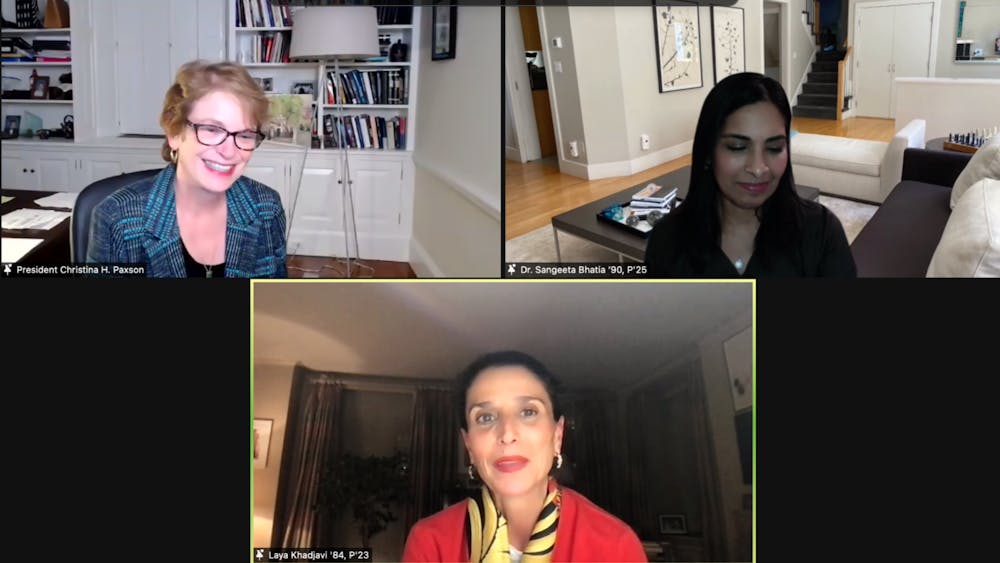President Christina Paxson P’19 and Sangeeta Bhatia ’90 P’25 commemorated 130 years since women joined Brown’s campus and 120 years since women of color joined campus in an event hosted by the Brown Women’s Network Monday. The pair reflected on the growing representation of women in STEM fields at Brown, as well as the work yet to be done.
Bhatia is an entrepreneur in the field of biotechnology, with a bioengineering degree from Brown. When Bhatia was studying at the University, she observed that women had “quietly, disproportionately dropped out” of the engineering concentration until only seven remained. While this phenomenon has vastly improved on the undergraduate level since her time at Brown, significant representation disparities still exist for women, and particularly for women of color, within STEM fields.
Speaking about the challenges women face in academia, Paxson referenced a 1996 study co-authored by Nancy Hopkins, a professor at the Massachusetts Institute of Technology and one of Bhatia's role models, discussing barriers to entry for women pursuing faculty positions.
In her own work, Bhatia said she calls upon Hopkins’ technique: “Data plus stories plus leadership … can make change.” Working with Hopkins and former MIT President, Susan Hockfield, Bhatia found that 40 more biotechnology companies could have been started since 2000 if these barriers to entry did not exist.
One significant barrier is the widespread exclusion of women from professional networks, according to Bhatia. Women, she said, are rarely asked to help cofound organizations and are absent from scientific advisory boards and boards of directors. Additionally, Bhatia noted, only 2.7% of available venture capital funding went toward women’s projects as of 2019.
For women of color, these disparities are magnified. The first woman of color enrolled at the University 10 years after white women were allowed to study at Brown. But the first undergraduate female engineer graduated from Brown in 1945, she said, while the first undergraduate female engineer of color graduated in 1976, 31 years later.
Expanding on the intersection of gender and race, and the disparities that exist along these lines, Paxson raised Henrietta Lacks’ story of “trust betrayed” and the consequent justified “deep mistrust within certain segments of the population in science.” Lacks, a Black woman, underwent a biopsy in 1951 while she was being treated for cervical cancer. Those collected cells, later to be named HeLa cells, reproduced infinitely and became foundational to the study of cancer biology, propelling highly profitable scientific discoveries in the field — though Lacks and her family would never reap the benefits from nor consent to the sale of her tissue.
In order to build “trust as a part of our healthcare disparity work,” Bhatia said scientific communities must create “scholarship around trustworthiness… (that involves) building relationships with communities … rather than going in, collecting data samples and leaving.”
Bhatia also discussed the myth that women in STEM need to choose between being a mother and advancing their careers. Bhatia, as a mother of two, said she looks to Marie Curie as a role model. Curie was also a mother to two children, and Bhatia was also inspired by her ability to sustain friendships alongside her impressive career.
“Women are more than their work and accomplishments,” Bhatia said. She maintains a work-life balance by setting aside one day per month for trips with her husband and “Mommy days” every Wednesday.
Bhatia recounted attending a graduation weekend before the COVID-19 pandemic spread and seeing a group of five women PhD graduates taking a group photo, “celebrating that sisterhood” in front of the University School of Engineering. “We really have come a long way,” Bhatia said.
To close the event, Laya Khadjavi ’84 P’23 discussed the value of the Brown Women’s Network, which she said can help women develop beyond their professions. “It’s also amazing to see Brown’s ethos in action, its interdisciplinary approach to education, to life in general and its aspiration to make the world a better place.”





